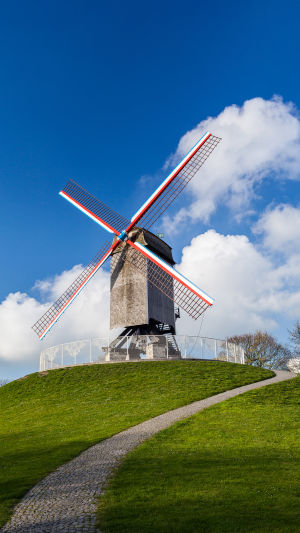A windmill is a powerful machine that uses wind as energy without fuel. Early wind turbines were also called windmills. Modern wind turbines mostly refer to wind turbines for power generation, and they are also used for water pumping and irrigation.
Ancient windmills were developed from sails. They had six to eight sailboat-like canopies distributed around a vertical axis.
Due to their low efficiency, this kind of windmill has been gradually replaced by wooden cloth windmills with horizontal rotating shafts and other windmills, such as "vertical windmills" and "automatic rotor windmills".
The windmill first appeared in Persia. It was a vertical-axis wing-plate windmill at first, and then a horizontal-axis windmill was invented. After the windmill was introduced to Europe, it was widely used in the 15th century. The Netherlands, Belgium, and other countries have built windmills with a power of more than 66 kilowatts for drainage.
Since the end of the 18th century, with the development of industrial technology, the structure and performance of windmills have greatly improved.
The characteristic of European windmills is that the blades rotate around the vertical plane. Because the wind is more variable in Europe than in West Asia, windmills also have mechanical devices to make the wings rotate in the direction of the wind.
Windmills are a part of European culture, especially for the "Kingdom of Windmills" Holland. Windmills, tulips, and slow-paced pastoral life are what the Netherlands is famous for. The Netherlands exudes tranquility, simplicity, beauty, and an ancient literary and artistic atmosphere.
In fact, the main function of the "Dutch windmill" is to pump water, mainly because the Netherlands is a low-lying country. A third of the Netherlands is only one meter above sea level, and nearly a quarter is below sea level.
In addition, due to the unique geographical location of the Netherlands, the westerly wind blows all year round. At the same time, it is close to the Atlantic Ocean, and the sea and land winds continue all year round, which provides generous compensation for the use of wind power in the Netherlands, which lacks water and power resources.
Therefore, the Dutch used the "Dutch windmill" to pump water and remove accumulated water in many lowlands to facilitate production and life.
Although the Netherlands is a modern country, it has not lost its ancient traditions. The windmill, which symbolizes Dutch national culture, still runs faithfully in every corner of the Netherlands.
In this "land of windmills," in its heyday hundreds of years ago, there were nearly 10,000 windmills. But the advent of other power machines, such as steam engines, internal combustion engines, and electric motors, made these windmills obsolete, and there are now only around a thousand left.
The Dutch consider the windmill the "hero" of their development. Therefore, the second Saturday in May is designated as "Windmill Day." On this day, windmills across the country turn together, and the whole country celebrates.
Because there are not many windmills, the Dutch, along with tourists from around the world, have to go to the Windmill Village Reserve or the Windmill Museum to see them all.
The windmill, with no energy consumption and no pollution, has become a symbol of new energy and environmental protection. The simple and beautiful figure of the Dutch windmill has become a symbol of Dutch culture and deeply attracts tourists from all over the world.
Overall, the windmill is an important part of human history and a symbol of our ongoing quest for clean and sustainable energy. From the early windmills of Persia to the modern wind turbines of today, this remarkable invention has been used to power everything from water pumps and gristmills to homes and entire cities.
And as the world continues to seek out new and innovative ways to harness the power of the wind, we can be sure that the windmill will remain an important and enduring symbol of human ingenuity and creativity.





